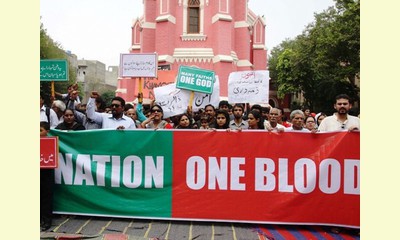|
|
One Nation, One Blood (Pakistan)
un articulo por Megan Andre
On September 22nd, 2013, there was an attack on
the All Saints Church in Peshawar, a Christian
church in the main town in Khyber Paktunkhwa
province. A twin suicide bombing that occurred
after a Sunday mass resulted in the death of over
100 people. According to Sahibzada Anees, one of
Peshawar’s senior officials, the area is a target
of terrorism and there was supposed to be a
special security arrangement for the church, but
something went wrong. This event is believed to
be the country’s deadliest attack on Christians.

click on photo to enlarge
On October 6th, 2013, 200-300 people formed a
human chain outside the St Anthony’s Church
adjacent to the District Police Lines at the
Empress Road in a show of solidarity. Mufti
Mohammad Farooq delivered a sermon in the small
courtyard of St Anthony’s Church that preached
tolerance and respect for other’s beliefs. Father
Nasir Gulfam, who was inside conducting service
inside the church, came out after his service and
stood next to Farooq, and the two men stood hand
in hand as part of the human chain that was formed
outside the church.
Many people held signs up, mostly saying ‘One
Nation, One Blood’ and ‘No More Dialogue… Only
Action!” The point of this chain was to try to
sensitize the public at large to these attacks,
and to try to prove that Muslims and Christians
can live in solidarity with one another.
Only around two percent of the 180 million people
in Pakistan are Christian, and they complain of
growing discrimination. Pakistan’s Ulema Council,
an association of leading Muslim scholars,
strongly condemned the church attack and said
killing innocent people violates the tenets of
Islam. “It is an extremely shameful attack which
has shamed all Pakistanis and Muslims,” Allama
Tahir Mehmood Ashrafi, chief of the council, told
AFP.
Mohammed Jibran Nasir, the organizer who made the
calls for the events on social media, flew out
with his group to St Anthony’s Church to
participate in the human chain. He and his group
advocate the need for interfaith humanity. Nasir
originally launched a Facebook campaign, asking
people to visit their local mosques and request
their Imams (the Muslim worshipper who leads the
recitation of prayer) to condemn the Peshawar
Blast. Although unsuccessful at first, he stated
“I was persistent as I believe that this is the
only way to create change”. He eventually got his
own Imam to mention something about the attacks.
It wasn’t much, but he believes baby steps are
better than no steps.
Overall, the goal of the human chain, as mentioned
above, is to prove that the insurgents that were
responsible for this attack should not define
Muslims at large. In order for change to occur
and for these attacks to come to an end, there
needs to be a more outward show of peace between
Christians and Muslims, or even cross-cutting
religions in general. What happened on September
22nd was an awful occurrence, and it seems that it
has opened the eyes of Pakistanis.
|








|
DISCUSSION
Pregunta(s) relacionada(s) al artículo :
How can different faiths work together for understanding and harmony?,
* * * * *
Comentario más reciente:
:
This discussion question applies to the following articles:
Creating Harmony in the World: Working through Our Faiths in Dialogue
Alternate Focus: Balance in Media Coverage in Middle East
The Parliament of the World's Religions (Barcelona, Spain)
Asian Religious Leaders Urge Religions To Teach Peace
Living Faiths Together – Tool kit on inter-religious dialogue in youth work
Sharing the right to Jerusalem's past
The Doha Pre-Forum of the United Nations Alliance of Civilizations
Peace For Childrens in Primary Schools in Iraq
Dialogue in Nigeria -- a new DVD teaching-tool for peacemakers
4th Annual International Conference on Religion, Conflict and Peace
First Religious Youth Service Project in Pakistan
World Harmony Day at the UN Highlights the Culture of Peace
Report of Diversity Talk Series 2013, in Lahore, Pakistan
Journée d'étude à Tunis: Religions et cultures au service de la paix
Workshop in Tunis: Religions and cultures in the service of peace
Out of the spotlight, Moroccan Islamic party promotes interfaith dialogue
Muslim and Christian youth come together in Mombasa, Kenya
Greeting of Peace from United Social Welfare Society, Pakistan
Interfaith Cultural Study Tour to Nepal: Pakistan Youth Explore the Mysteries of Nepal
One Nation, One Blood (Pakistan)
Teachings of Peace
Overview of the Book, Paganism an Introduction to Earth-Centered Religions
La líder de un movimiento interreligioso Dena Merriam recibirá el 31 Niwano Peace Prize
Dena Merriam, Founder and leader of The Global Peace Initiative of Women to receive the Niwano Peace Prize
Pakistan: Scholars adopt charter of peace, support coexistence
Lebanese dialogue aims to strengthen unity in diversity
Un an du "Projet Revalorisation du Vivre Ensemble – REVE" au Niger
A Year-long Project for "Living Together - REVE" in Niger
Beating the drum for peace: A chat with the general secretary of the South Sudan Council of Churches
There’s a Place in India Where Religions Coexist Beautifully and Gender Equality Is Unmatched
Click here for articles since 2016.

|
|









